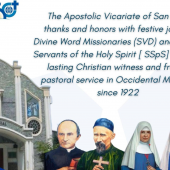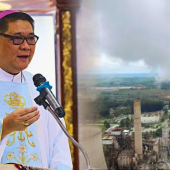Mission in the city
At the Second National Mission Congress (April 17 t0 20, 2022), a series of talks on the mission were organized as the concluding activity for the Jubilee Year celebrating 500 Years of Christianity in the Philippines, Asia’s predominant Catholic country.
Father Andrew Reception, a professor of Missiology at the Pontifical Gregorian University in Rome shared his thought on one particular aspect of the “Mission in the City” which is a perspective on the Mission in City from a landscape to humanscape.
There are fundamental questions we need to ask when we talk about “Mission in the City.”
First, why do people go to the city and live in the city? Second, what will the city in the future be like? And lastly, what do I find in the city?
One factor people go to the city is to have a better opportunity. Second, in the city people live in multiple settings. People also go to the city because they live even if they are in the midst of the city, they are marginalized. For many reasons, economically marginalized, they are socially marginalized, and probably they also religiously marginalized. Thus, we have so many existential peripheries that can be found in the city.
When we talk about the city, there are both positive and negative realities of it. The positive realities of the city include; fast progress compares to other places in remotes or villages, multicultural as cities are the melting part of all kinds of cultures. Other positives side of the city is post-modernity which describes a condition embraced by young adults in which they have little or no record of religious values. For them what is important is a colleague and happy existence. Lastly, upward mobility is a fact in which the push, passion, and drive for a professional career are so competitive.
Meanwhile, the negative realities of the city are social inequality as many people do not have stable jobs which can lead to the second negative reality of the city which is criminality. Prostitution becomes one of the easiest ways to get money who do not find any jobs. Social displacement is a rise because of unemployment which is connected to marginalization or poverty. And finally, traffic congestion and pollution added to the negativity of the city as it is overpopulated.
There are three fundamental challenges of the cities today after the Covid-19 pandemic and now during the war as the situation of peace is very much challenged.
First, the economic recession is a very high incident of unemployment in our cities. In fact, during the pandemic, many lost their job. Second, climate change and extreme weather; after the 2020 pandemic, there is an increase in gas emissions. It was noted that during the pandemic gas emission decreased, but after the pandemic gas emission increased. Thirdly, treats individuals’ well-being. The pandemic has caused a lot of serious toll on mental health due to financial insecurity and fear of unemployment. Many also lost their lost ones which resulted in emotional and mental scars.
Having reflected on the realities of the city, we need to ask ourselves; where is the mission? Where is it going? In one of the articles, it says that the mission is going back to the understanding of human beings and that is the first important task of the mission.
“The importance of making cities more human and nurturing a strong sense of connection, shedding light on what cities should care about the most–people,” (Urban future with a purpose 2021).
Thus, where is the mission going? We do not have to go very far. We start with people. We start with the person next to us. There we are sent—to reach out, to bring the message, the good news. We have to rethink our mission. We just do not have to think about the city as a place where you have high-rising buildings, traffic, and all kind of infrastructures or structures. We have to rethink the mission.
Rethinking a mission entails four elements; the Christian mission has to adapt, anticipate, evolve, and innovate. If we want the Christian mission to be effective in the context of the city, we have to adapt to the city. We have to anticipate how to proclaim the gospel to men and women in the city. We cannot just rely on what we have done in the past. We have to evolve, to be creative. We have to find new ways, new pathways of mission in the city.
Lastly, we have to innovate. We cannot simply recycle things. We the guidance of the Holy Spirit, we have to ask how we can better proclaim the gospel and bring the message of Christ to all in the context of the city.
With these four pillars of rethinking the mission in the city, let us have a sort of missiological mapping of the city. Going back to the data provided by the United Nation and some other organizations, we are challenged by the reality of our world today. It says that we have to create an equivalent of one new city of one million every five days. So, we have to create one city every five days between now and 2050 to accommodate all people who want to go to the city. More and more people will indeed be going to the city.
In 2008, according to statistics, half of the global population, that is about 3, 5 billion people lived in urban areas. In 2014, 54% of the world’s population lived in the cities with 1.4 million people migrating into megacities each week all over the world.
In 2015, 3,9 billion people live in urban centers. According to projections, this population will double in 38 years. More people will be living in the cities. By 2030, according to projections,
five billion people will live in the cities and three out of five people on earth will live in the cities.
In 2100, it says that there will be an additional three out of five billion people who will be living in the cities. This reality added a burden to the cities and added to this, there are one billion migrants in the world today.
With this global picture of the cities with migration, we should ask, what are the challenges of doing missions in the cities? We need a new map of mission in the cities because we think always a mission is as if we go to a remote place in the world.
Missiologists today say that we need to go into the city because it is where more people will be living now and in the future. Hence, if the Church has to rethink its mission, they have to think about the city. What do we do about the city?
It is not enough to have and be in a nice parish in the city, but what is our strategy? How we do reach out to people living in the cities? From what perspective do we draw our passion, our commitment to bring Christ to people in the city?
When we talk about a mission, we are not talking about a place only or something like a local place. We are talking about humanity–people. When we talk about the Christian mission, we are talking about people. When we go back to Jesus, he did not just go to a place. The place was secondary for Jesus; the most important thing is to be with people. That is important when we talk about missions in the city.
As Christian, do we take seriously the attitude of Jesus that we have to stay with people? We have to reach out to people, to know and find every person as our mission space. When we talk about mission in the city, we need to remember that there are many human and existential frontiers in the mission. We have to take note that if we want to do a mission significantly in the city, we have to start from the outskirt-the edge, not from the center, and from there we may understand the best way for us to do the mission.
It is important to remember what Pope Francis says in Evangelii Gaudium (The Joy of the Gospel 2013), “We need to look at our cities with a contemplative gaze, a gaze of faith that sees God dwelling in their homes, in their streets, and square” (EG 71).
We cannot do a mission simply as an activity according to Pope Francis in his apostolic letter about the Joy of the Gospel. He says that we have to see the city with the eyes of God, with the eyes of faith.
What does my faith tell me when I am in the city? What does my faith, and what does Jesus want me to do when I am confronted with the person who is lost in the city?
It is important to highlight that a city is a mission space. It is not just a place; therefore, we need to enter into dialogue with men and women in the city. Dialogue comes from listening. As Christians, pastors, and religious workers, we need to have that capacity to listen to people in their grief, worries, anxieties, and travails.
We need to understand a few fundamental shifts in the way we think about missions. First, the mission is to understand new cultures in the city. What are the new cultures in the city? In EG Pope Francis talk about new languages, symbols, messages, and paradigms that propose new approaches to life. In an emerging new culture in the city, many people do not have reference to any religious values at all. Therefore, the mission in the city is not only ‘faith seeking understanding, but the mission is also faith seeking connection’—by finding new ways of relating to God, to others in the world, inspiring essential value, friendship, solidarity, maturity, and encounter. We should never impose a top-down mentality. A way of doing things is very doctrinal, but we have to imagine innovative spaces and possibilities for prayer and communion in the city.
Second, the mission is divine self-reaching out through God’s living people. Then, the mission is the faith that reaches out to people. Reaching out, embracing the stories of the people. Mission according to EG must reach the places where new narratives and paradigms are being formed bringing the words of Jesus to the inmost soul of our cities. Aware of the life stories of the people in the cities, to be in dialogue with them through their stories of faith and life. Reaching out to embrace multicultural realities and connective networks is an important part of missioning in the cities.
Third, the mission is to encounter solidarity. In EG 75 Pope Francis says; “Houses and neighborhoods are more often built to isolate and protect than connect and integrate,” EG 75.
There is a lot of indifference in the city. There is a lot of suspicion of people. To be Christians, we need to have a heart that works for encounters and solidarity with people.
In the word of Pope Francis, mission in the city means taking every opportunity to reach out to the least, the last, and the lost. And to reach out to those who can make a difference in the community, not only the poor, and the marginalized but also those who have power, who have influence, and who have resources to make difference in the community. Mission in the city is not just an activity but more a way of life for Christians that give witness to Jesus.
There are three ways to do a mission in the city corresponding to three fundamental shifts namely; first, we need to be critical of the city in a positive way because we are a contrasting society of the Gospel. We need to have prophetic courage, the harmony of word and action, and self-critique.
Second, we have to be creative in bringing Jesus to the world by proposing a new way of being a human community, transforming structures and reorienting contrary values, and forming a seed of new humanity in Christian’s social conscience.
Lastly, we need to collaborate with people of goodwill through apostolic synergy; work with experts; highlight values of reciprocity, generosity, and community; multi-pronged approach to dealing with issues, and create ripples of collaboration in the civilization of love.
To do all of these we need a spirituality of being at home with Jesus in the city. We need faith stamina to live our faith genuinely, authentically, and meaningfully in the city. And we need to live a mission in the city reaching out to people in whatever situation of life.
Having said these, are you ready for Mission in the City? (With the assistance of Emiliana Saptaningsih, RVA News)
Radio Veritas Asia (RVA), a media platform of the Catholic Church, aims to share Christ. RVA started in 1969 as a continental Catholic radio station to serve Asian countries in their respective local language, thus earning the tag “the Voice of Asian Christianity.” Responding to the emerging context, RVA embraced media platforms to connect with the global Asian audience via its 21 language websites and various social media platforms.














